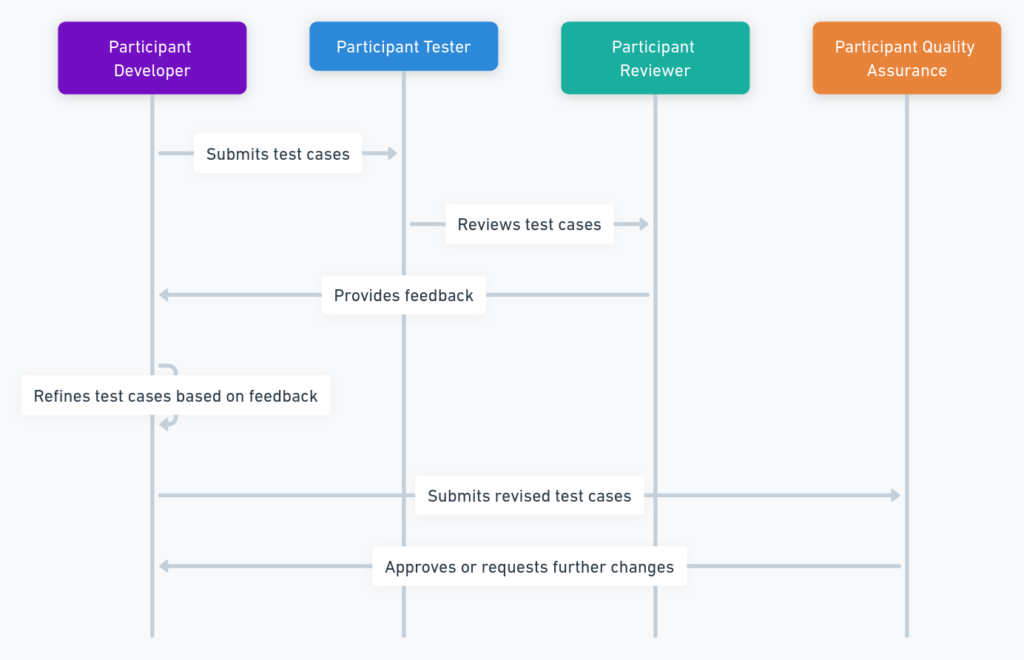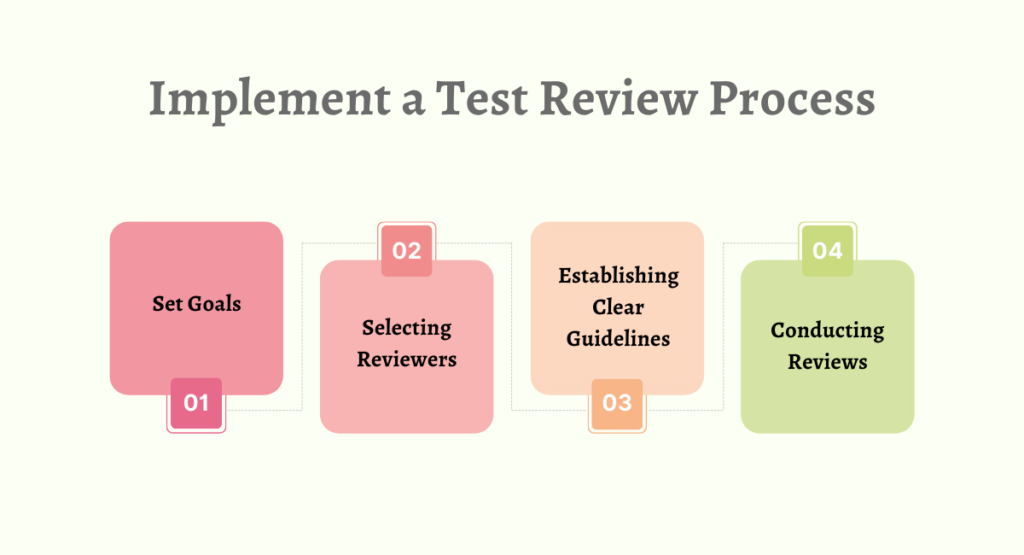Software development professionals understand the value of code review as an essential element of quality assurance, to ensure code is not only functional but also clean and manageable.
In parallel with code reviews, testing reviews have become an increasingly essential component of testing processes.
Test review processes often go underappreciated when it comes to building high-quality software products. Test review involves carefully inspecting the design, implementation and effectiveness of tests themselves - much like code review does with actual code itself.
Adopting a test review process enables development teams to achieve a more robust and efficient development cycle, leading to improved product quality and reduced time-to-market.
In this blog, we explore some critical points which show why including this practice into your quality assurance strategy is imperative.
Importance of Test Reviews

A test review is the systematic examination of testing artifacts such as test plans, cases and scripts by team members other than their original author in order to identify defects, ensure alignment with project objectives and verify the test's ability to effectively detect software issues.
Similar to proofreading documents and procedures before they are put into use in an actual testing phase.
Test Review in Comparison
Test review shares many similarities with code review, an established practice in software development in which peers peer-review source code to detect bugs, enforce best practices and ensure consistency.
Both processes aim to enhance product quality and reduce error risk; however, test review focuses on testing strategies rather than code itself; this highlights its complementary roles within the software development lifecycle.
Benefits of Test Review
Undergoing test reviews offers multiple advantages in software development:
- Enhance test quality: By reviewing test cases and plans, errors such as missing scenarios or vague requirements can be quickly identified and addressed as soon as they arise.
- Efficiency in testing: Reviewed tests are more likely to cover all areas of software, reducing the chance of defects slipping through at later stages.
- Increased collaboration: Test reviews promote team interaction and knowledge exchange between members, leading to increased knowledge sharing about application functionality and testing among team members.
- Faster development cycles: By conducting comprehensive and accurate tests, debugging becomes more streamlined and time-efficient, speeding up the development process.
Implement a Test Review Process

Set Goals
The initial step in developing a test review process is setting clear objectives.
Goals could range from meeting testing standards, verifying functional requirement coverage or detecting redundant or unnecessary tests - clearly stated goals help keep everyone focused and provide a way to assess its success.
Selecting Reviewers
Finding suitable personnel to conduct test reviews is of utmost importance, as reviewing should require experts with relevant expertise who are also aware of the project context.
Involve team members from diverse roles - developers, QA engineers and business analysts are especially valuable - so as to bring different viewpoints to review processes.
Establishing Clear Guidelines
In order to ensure consistency and thoroughness during the review process, it is necessary to establish clear guidelines. These should include aspects like scope, deadlines, feedback mechanisms and criteria for accepting or rejecting tests.
A standardized checklist may prove especially helpful in helping reviewers navigate this step-by-step process.
Conducting Reviews
In practice, conducting reviews involves several steps.
- Prep Work: Accumulating all necessary test artifacts and disbursing them among reviewers.
- Exam: Reviewers independently inspect test materials to assess them against objectives set.
- Discussion: After reviewing their findings and making any necessary improvements, reviewers meet to share and discuss them.
- Revision: Based on feedback received, the test case author revises artifacts in order to increase clarity, coverage, and effectiveness.
- Follow-Up: Should the process need repeating in order to maintain quality or meet project specifications, further steps may be necessary.
By following these comprehensive steps, organizations can significantly enhance the reliability and effectiveness of their software products.
Challenges in Test Reviews
Test reviews present unique obstacles that can reduce their efficiency. Acknowledging them will lead to an efficient testing environment in your software development lifecycle.
Common Obstacles
One of the main hurdles of test reviews is an absence of standards or benchmarks for testing. Without definitive guidelines to rely on when reviewing test cases and scripts objectively.
Unother significant challenge involves team members' unwillingness to fully engage due to biases against highlighting flaws in peers' work or time constraints.
As this process involves reviewing a wide variety of tests - ranging from unit to integration and system tests - it requires special expertise and attention from team members with varied technical skill sets to conduct complete and effective reviews of complex test scenarios or automation scripts, potentially leading to incomplete or ineffective reviews by some team members.
Overcoming Challenges
To effectively meet these hurdles, organizations should establish clear and comprehensive test standards and procedures that are easily understood and accepted across their organization.
Training workshops can equip team members with the necessary skills for conducting thorough and constructive reviews; using automated tools can standardize review processes while decreasing reviewer workload - making the review process less time consuming for human reviewers while creating a positive culture that emphasizes quality assurance and constructive feedback can encourage active contributions by team members who contribute proactively towards test reviews.
Strengthen Your Testing Processes Through Reviews
Implementing robust test review processes not only addresses the challenges mentioned, but can also dramatically enhance software development projects in terms of quality and efficiency.
Enhancing Quality Assurance.
Test reviews play an essential part in improving software product quality. By regularly scrutinizing test strategies and executions, teams can identify flaws not only in their software products but also within the testing strategies themselves.
By doing so, errors are identified early and corrected early on, thus decreasing cost and time associated with fixing defects post-release.
Furthermore, continuous feedback loops from test reviews strengthen tester skills over time leading to more effective scenarios and coverage over time.
Streamlining Development Cycles
Review of tests is also instrumental to speeding up development cycles.
By making sure every test is reviewed and validated before being deployed, project teams can prevent bottlenecks caused by failed tests or bugs discovered during later development stages - not only speeding up deployment but also increasing collaboration among developers, testers, and quality assurance professionals.
Effective reviews ensure all team members aligned with project goals and quality benchmarks which speed up decision-making while shortening time-to-market for software products.
Through incorporating test reviews into their regular development practices, organizations can achieve a more reliable, efficient, and collaborative testing process, further strengthening the integrity and competitiveness of their software solutions.
Book a Demo and experience ContextQA testing tool in action with a complimentary, no-obligation session tailored to your business needs.
Conclusion
With software development continuing to rapidly progress, quality and reliability assurance of software products has never been more essential.
Adopting a test review process similar to code review can transform the testing process, creating an environment of collaboration that not only detects errors early but also increases team knowledge about project-specific testing methodologies and requirements.
This practice not only reduces bug rates significantly but also shortens development cycles by promptly and accurately addressing issues that arise.
Integrating test reviews into software development teams' everyday practices will provide significant advantages in terms of both product quality and staff knowledge.
Even the modest time investment needed for testing reviews could yield substantial time and cost savings in the long run, making this form of evaluation indispensable in today's highly competitive tech sector.
Also Read - Who Needs QA? Importance of Quality Assurance in Software Development
